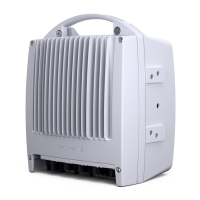MINI-LINKEandEMicro
Power Detector
A sample of the transmission signal is used for supervision of the transmitted
power (output power alarm).
3.4.3.3 RF Loop (Only RAU1 15-E, 18-E and 23-E)
A sample of the transm ission signal is m ixed with a shift oscillator signal and is
fed into the receiver for test purposes.
3.4.3.4 RF Attenuation
In addition to the transmitter output power control described above, the output
RF level may be fur t her decreased by fitting fixed RF attenuators to the
microwave unit. The transmitted RF can then be attenuated by a total of 50
dB for RAU1 23-E, 26-E and 38-E. For RAU1 15-E and 18-E, the transmitted
RF can be attenuated by a total of 33 dB. See Section 8.1.1 on page 126 for
more details.
3.4.3.5 Receiver Block
The received signal is fed from the input branching filter into a low noise
amplifier (with the exception of RAU1 38-E) and a down-conver ter to a first IF of
approximately 1 GHz. After bandpass filtering and amplification, the signal is
down-convert ed to the second IF of 140 MHz.
Receiver Oscillator, Multiplier and Filter
LO signals for the two down-conversions are generated in the same way as for
the transmitt ed signal. A frequency control signal from the MMU (AFC) is fed to
the receiver oscillator by the control and supervision processor.
This double superheterodyne receiver with a high first IF enables frequency
selection over a wide frequency band, with excellent receiver spurious and
image rejection.
34
AE/LZT 110 2012 R8C 2002-03-04

